If you kill one of these plants, you have a black thumb, not a green thumb !! :) Dietes is the Botanical name for the plant called the Fortnight Lily, or African Iris, along with several other common names. They are not related to Iris, this is only a common name used for them ! This plant is tough and very hardy, but will always benefit from extra care, and will look better for it. Most species of this plant are from Africa, so it is suited for temperate and warmer climates, and flowers for most of the year. There are only about 6 species of this plant, but two of them, Dietes bicolor and Dietes iridoides are most common in Sydney.
Dietes bicolor is the larger plant of the two, having long arching sword-like leaves with pale yellow flowers and darker brown spots on the petals. The plant grows into a large clump and is very attractive when mature. Dietes iridoides is more of an upright clumping plant, the shorter sword-like leaves pointing straight up. The flowers are an attractive mix of yellow, white and blue.
Pruning off the dead foliage and flower heads will improve the look of the plants, and give it a sunny spot and well-drained soil for best results. I took these photos in different locations around Sydney.
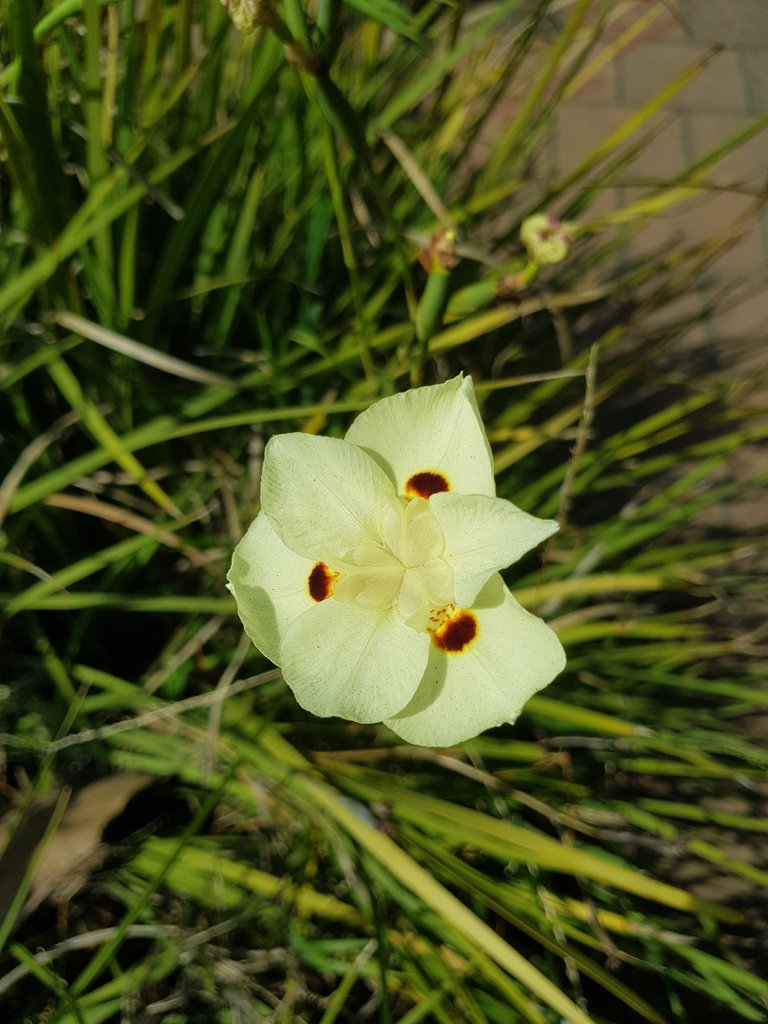
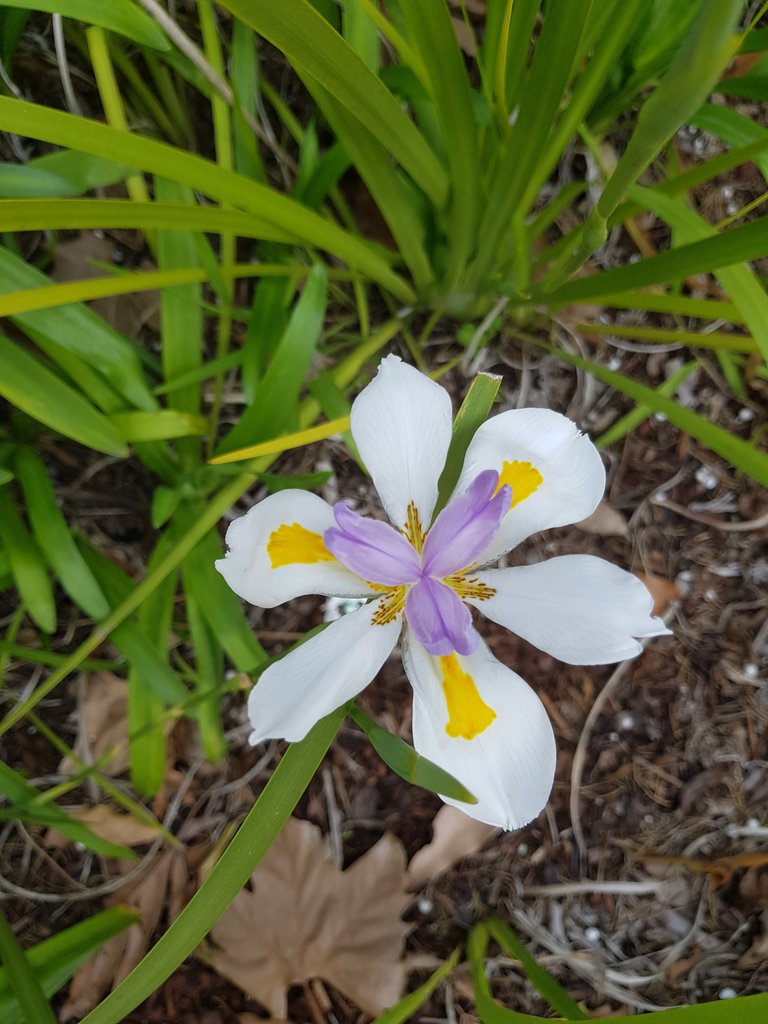
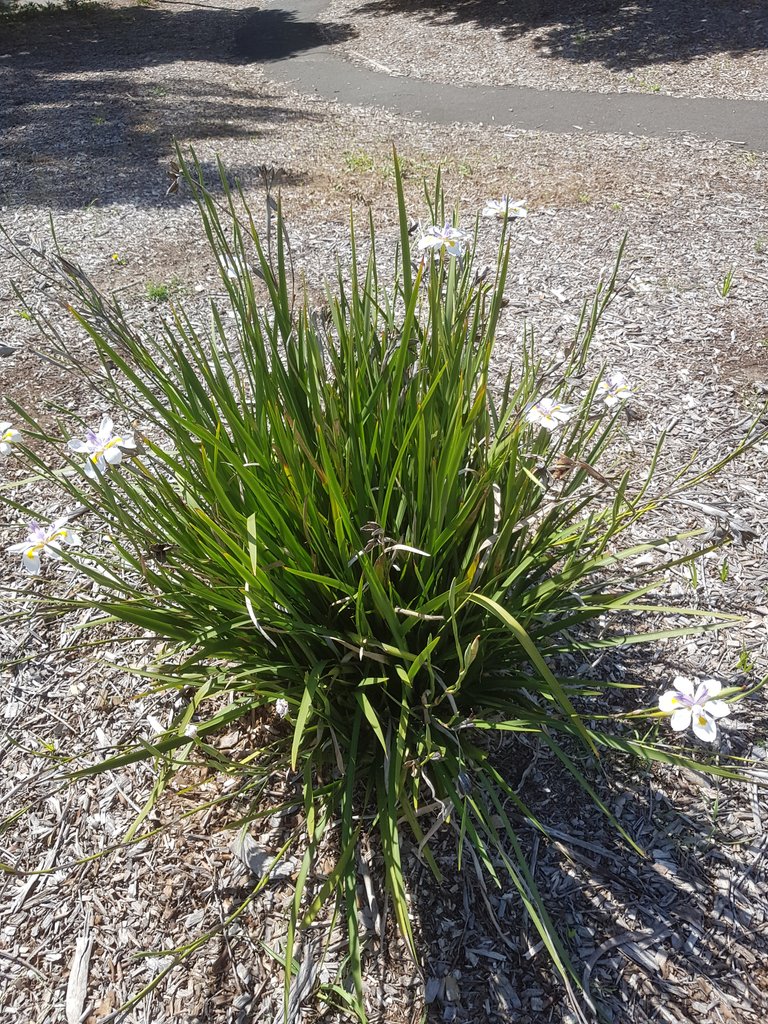
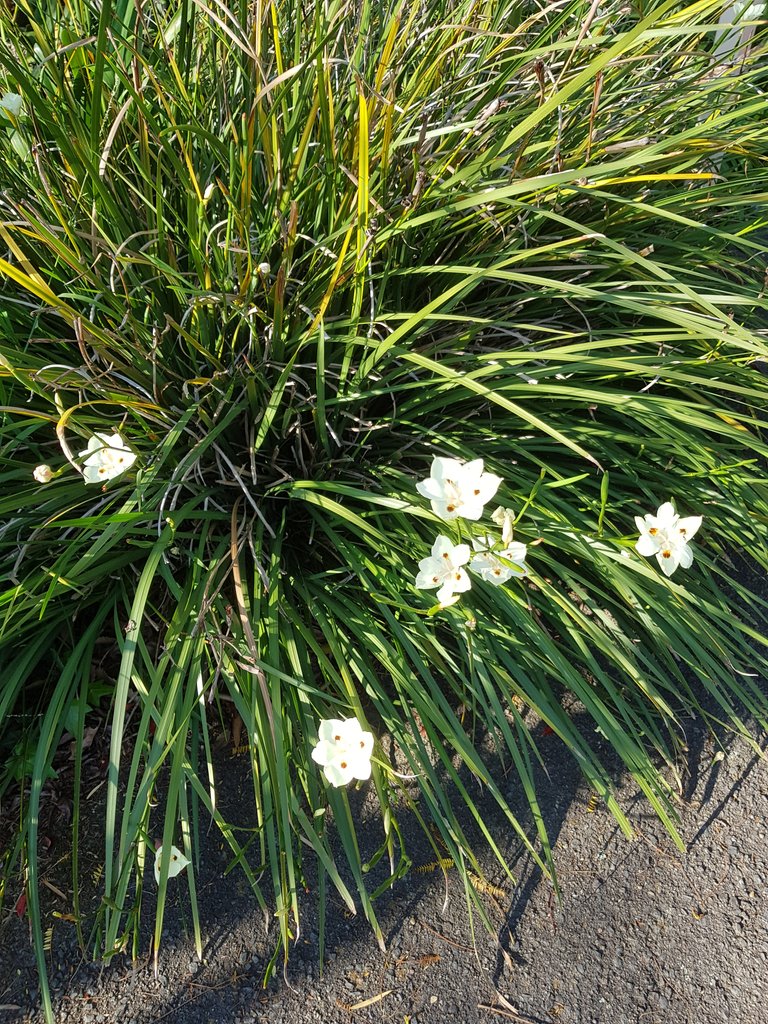
Two-color diets and Iris-shaped diets A completely unpretentious rhizomatous plant, practically not damaged by pests, blooms for a long time and abundantly. Can be grown as a houseplant or garden plant.
Perennial, evergreen, rhizomatous plant up to 1 m tall. The leaves are long, narrow, sword-shaped, dark green. The flowers are large, white, cream or yellowish with three dark maroon spots.
Here are some photos from the Internet
http://edenland.com.ua/semena/dietes-dvukhtsvetnyj.html
https://m.my.mail.ru/inbox/temko/photo/15419/16592.html
Thank you for sharing a new type of plant for me :)
Fav. comment Award ! Thanks for your good selection of Pics.
Amazing flowers @ctrl-alt-nwo! A very hardy landscaping plant with a clumping grass-like appearance which produces pale yellow flowers during Spring and Summer. Great for borders in full sun positions.
Synonyms (AKA): Peacock Fower, Wild Iris
Typical height: 60 to 80cm
Minimum temperature tolerance: Tolerates frost
Climate: Grows well in most parts of Australia
Light conditions: Full sun to part shade
Growth habit: Clumping
Growing conditions: Well drained soil
Flowers: Spring / Summer
Origin: South Africa
A source: http://www.bambooland.com.au/dietes-bicolour
Silly sausage Award ! Great choice of Pics, thanks.
Wild iris, or butterfly plant, as it is also called, is a delight to grow. It is a tough plant that will grow in most soils and, once established, will survive harsh growing conditions – even tolerating drought. Conversely, wild iris (Dietes spp.) will also grow in boggy gardens. It can be grown in full sun or semi-shade and is usually pest- and disease-free.
There are five indigenous species of wild iris – Dietes bicolor, D. butcheriana, D. flavida, D. grandiflora and D. iridioides. All these species, but especially the yellow wild iris (D. bicolor) and the large wild iris (D. grandiflora), make attractive garden and landscape plants. The blooms of the latter two are borne on top of long flower stalks above 90cm-tall foliage. Their leaves are evergreen and grass-like, and the plants grow to form attractive clumps.
https://www.lifeisagarden.co.za/dietes-pretty-tough-plants/
Fav. comment Award ! Well done on your selection of Pics.
@ctrl-alt-nwo,
I can assure I didn't see these flowers in my country! It's a bush type! Personally I hate bush type plants! Coz sneaks can use it as a hidden place! But I like these flowers! They looks so wonderful and cute! Nice photography and a description about them! Thank you!
Cheers~
One of the most versatile plants around and a great plant for beginning gardeners. This African native can tolerate virtually any soil conditions from drought to moist soil found at the water’s edge. Requires little maintenance to maintain a neat appearance. Just remove faded flowers to keep plant looking fresh. The spiky foliage adds great texture and interest to formal settings or plants can be naturalized for a casual, carefree look. Blooms last only a day or two but are produced over a long season through the spring and summer.
Prepare the garden by breaking up the existing soil (use a hoe, spade, or power tiller) to a depth of 12-16” (30-40cm). Add organic matter such as manure, peat moss or garden compost until the soil is loose and easy to work. Organic ingredients improve drainage, add nutrients, and encourage earthworms and other organisms that help keep soil healthy. Give plants an extra boost by adding a granulated starter fertilizer or all-purpose feed that encourages blooming (for example fertilizers labeled 5-10-5).
https://www.mygardenlife.com/plant-library/6661/dietes/iridioides
Thanks again for sharing some lovely photographs.
Shared on twitter promoting great quality content on #Steemit.
#Promo-Steem #steemtalent #JoinSteemit #Steemit
Un-killable Dietes. #STEEM #steemtalent #JoinSteemit #Steemit
#garden #gardening #gardensworld #plant #life #blog #blogger #australia #photography #photographer
Thanks for sharing on Twitter again too !
Those are rare in las vegas... we only have palm trees and cactuses here haha
I was there about 20 years ago. Loved it !
Dietes grandiflora is a perennial, evergreen plant which grows up to 1.5m in large clumps. The plants grow from underground rhizomes.The long, rigid, sword-shaped leaves, held in a fan shape, are dark green and may reach up to 1m long and 15-20mm wide.The attractive flowers, held on erect slender stems about 1m in length, are large (about 100mm across) and are white with yellow nectar guides and outer tepals and violet central segments.
The flowers are borne in mass at certain periods — often after rain in summer. The individual flowers do not last more than a couple of days (so are of no use in a vase) however, the plant bears so many flowers during the peak period that the plant looks most striking. This plant is occasionally called the "Fairy Iris" because the fragile white petals not only look like fairy wings, but also have a tendency to disappear mysteriously overnight! The large wild iris fruit is a large capsule up to 45mm which is held erect and splits open to release shiny, dark brown seeds.
Source: http://pza.sanbi.org/dietes-grandiflora
Congratulations @ctrl-alt-nwo!
Your post was mentioned in the Steemit Hit Parade in the following category:
Thanks for the mention again !
You're welcome
Fortnight lily
Formerly classified in the genus Moraea, and is still called morea iris by some gardeners. These are evergreen perennials with spreading fans of stiff, leathery sword shaped leaves up to 2 ft (0.6 m) in length but only 0.75 in (1.9 cm) wide. The upright clumps of leaves are held in a vertical fanlike plane and they spread on creeping rhizomes which sometimes ascend a few inches. The 2-4 ft (0.6-1.2 m) flowering stalks, which are perennial, are branched and stiffly wiry, bearing a succession of short-lived irislike flowers throughout spring and summer.
The flowers, rather flattened and nearly 3 in (7.6 cm) across, are milky white with yellow markings on the three larger tepals. (The three petals and three similar sepals of iris flowers are collectively called tepals.) Fortnight lily fruits are 1-2 in (2.5-5.1 cm) football shaped, three-sided capsules.
The fortnight lilies are often grown in borders because the narrow leaves are evergreen, and provide a strong vertical element. They're good along foundations, too. Fortnight lilies eventually form dense fan shaped clumps of leaves, and make a dramatic ground cover under large, tall trees. The flowers are beautiful, and although each lasts only a day, they are produced in profusion over an extended period from spring until late summer. They usually come in bursts, with a fortnight (two weeks) of rest between flowering events. Fortnight lilies seem to perform best in the light dappled shade of tall, open trees.
References1234
As always, I was pleased to learn about new plants for me.
http://www.plantarium.ru/page/image/id/414239.html
Diets bicolor (Dietes bicolor) Rhizome perennial 60-90 cm tall. Leaves are basal, narrowed-xiphoid, light green, 60 cm long. Light yellow to bright yellow, flowers 4 cm in diameter with 3 large perianth petals and brown spots at the base. Flowering in May and June.
http://www.balandin.net/Flora/Flora-cult-D.htm
This is such a classic and beautiful flower
Very dainty and beautiful flowers looking very much like iris! I haven’t seen these here yet though. Good to know that they come from Africa originally. They can gris in hot and humid condition here!
Posted using Partiko iOS
Interesting, even more the 2nd photo. Looks like a flower inside flower.
The bicolor diet is an annual plant that is arranged in a thick clump and has a rhizome. This plant has long, sword-like leaves, pale green leaf color. This plant belongs to the Iridaceae tribe, related to the Iris flower.
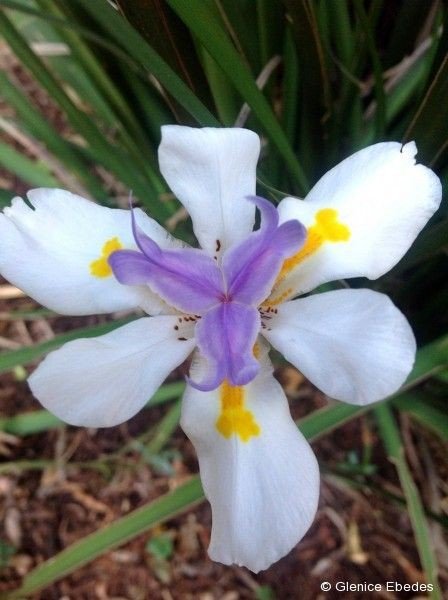
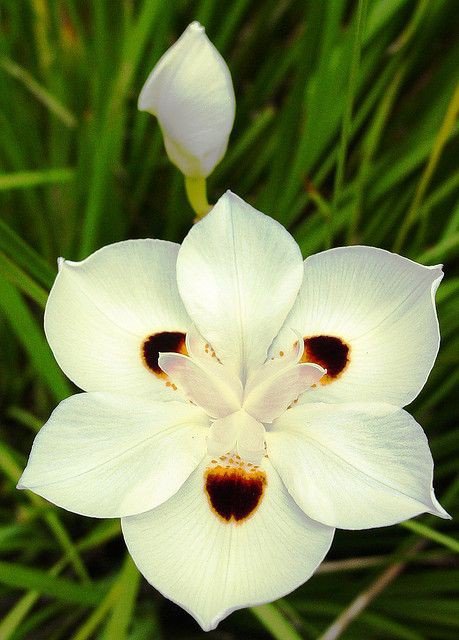
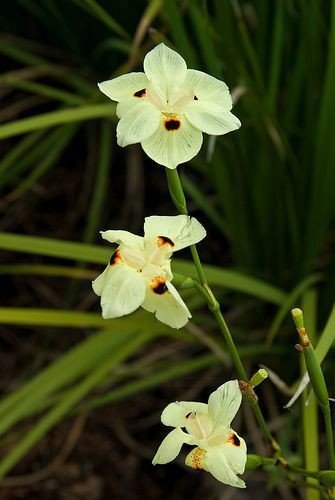
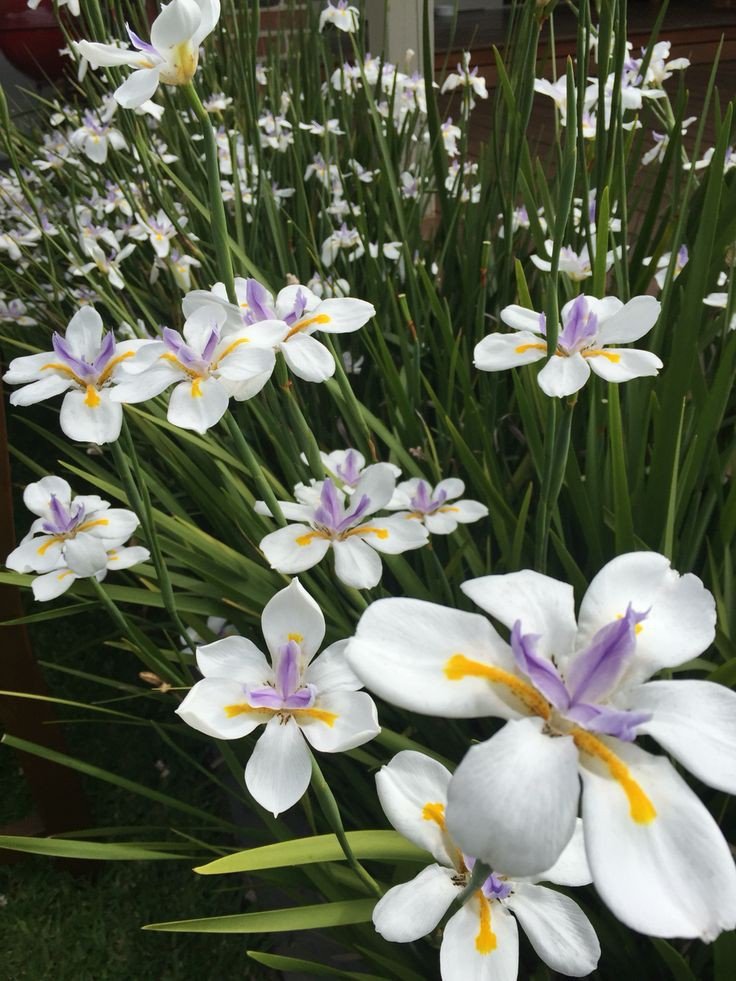
Bicolor diet is an ornamental plant with flowers that are cultivated in South Africa, where these plants are often found in city parks and as a garden to beautify buildings.
Diet Bicolor has yellow flowers with three dark purple dots on the flower crown. This plant also has a type of white flowering. Flower diameter of about 60 mm. Average flower strands of three marginal strands. Flowers that have a dark purple color on the bottom (outer) circle.
Flowers from the tip of the flower Nectar stalk are located on the outer edge. Flowers that bloom only last for one day because the number of buds is very large, the Diet plant continues to grow until October or in the spring and summer.
A bicolor diet is tolerant to dry environmental conditions and also frozen conditions. This plant can also grow easily in soil conditions that do not allow it to grow properly in environmental conditions with partial shade but still full sunlight.
Source:
https://www.google.co.id/url?sa=t&source=web&rct=j&url=https://bibitbunga.com/tanaman-dietes-white-blue/&ved=2ahUKEwi8hszEi5neAhUMuY8KHaV8Dh0QFjALegQIBxAB&usg=AOvVaw2dzyxKXYVnl9cOV2fhTYjX
Very beautiful plant, one more which I see for the first time thanks to you. Thank you for that.
Dietes is a genus of rhizomatous plants of the family Iridaceae, first described as a genus in 1866. Common names include wood iris, Fortnight lily, African iris, Japanese iris and Butterfly iris, each of which may be used differently in different regions for one or more of the six species within the genus.
Most species are native to southern and central Africa, with one (Dietes robinsoniana) native to Lord Howe Island off the coast of Australia. A few species have become naturalized in other parts of the world
These plants were formerly placed in the genus Moraea, but were reclassified because they are rhizomatous. Like Moraea, they differ from Iris in having flowers with six free tepals that are not joined into a tube at their bases.
Dietes bicolor has cream or yellow flowers. D. grandiflora and D. iridioides both have white flowers marked with yellow and violet, and appear similar in photographs, but they are quite different: those of grandiflora are much larger, last three days, and have dark spots at the base of the outer tepals, while those of iridioides are small, last only one day, and lack the spots. D. grandiflora is also a larger plant overall.
source
It is amazing how it is very resilient @ctrl-alt-nwo but who wants to kill a plant with some fantastic flowers?
You would be surprised, i have seen some really bad gardeners :)
Wild iris, or butterfly plant, as it is also called, is a delight to grow. It is a tough plant that will grow in most soils and, once established, will survive harsh growing conditions – even tolerating drought. Conversely, wild iris (Dietes spp.) will also grow in boggy gardens. It can be grown in full sun or semi-shade and is usually pest- and disease-free.
There are five indigenous species of wild iris – Dietes bicolor, D. butcheriana, D. flavida, D. grandiflora and D. iridioides. All these species, but especially the yellow wild iris (D. bicolor) and the large wild iris (D. grandiflora), make attractive garden and landscape plants. The blooms of the latter two are borne on top of long flower stalks above 90cm-tall foliage. Their leaves are evergreen and grass-like, and the plants grow to form attractive clumps.
Dietes are sensitive to long periods of frost, with the exception of D. grandiflora and some D. iridioides varieties that can withstand moderate frost as long as it is not for an extended period of time. Although tolerant of a variety of growing conditions, dietes perform best when planted in well-composted, slightly acid soil and need regular watering in summer.
https://www.lifeisagarden.co.za/dietes-pretty-tough-plants/
Never seen those nearby me but looks pretty cool hopefully one day i will see that :)
Dietes is a genus of rhizomatous plants of the family Iridaceae, first described as a genus in 1866. Common names include wood iris, Fortnight lily, African iris, Japanese iris and Butterfly iris, each of which may be used differently in different regions for one or more of the six species within the genus.
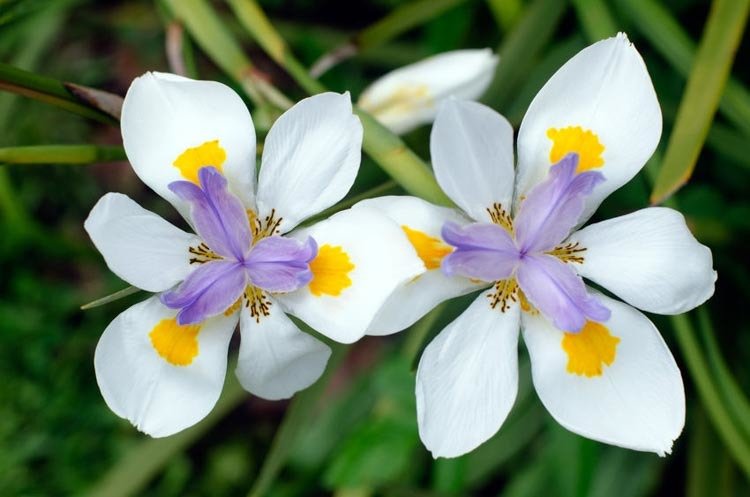

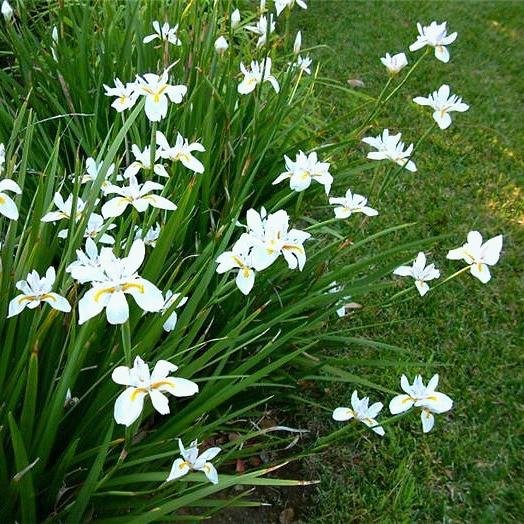
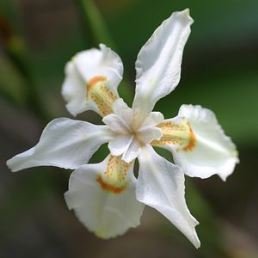
Most species are native to southern and central Africa, with one (Dietes robinsoniana) native to Lord Howe Island off the coast of Australia. A few species have become naturalized in other parts of the world.These plants were formerly placed in the genus Moraea, but were reclassified because they are rhizomatous. Like Moraea, they differ from Iris in having flowers with six free tepals that are not joined into a tube at their bases.
Some references mention the species Dietes vegeta or D. vegeta variegata, springing from some confusion with Moraea vegata (which grows from a corm, not a rhizome). The name D. vegeta is commonly misapplied to both D. grandiflora or D. iridioides.
Source.
@ctrl-alt-nwo, Un-killable Dietes Plant for sure sounding unique and very exciting to read about this for sure. But here i want to say one thing and that is I've never seen these kind of Beautiful flower pieces which are naturally designed in an Artistic way and i am sure that these are reflecting as Art Pieces and just see that second flower which is purely reflecting as it have many layers of beautiful creations. And i can call it as Random Plant because in one of the picture we can see that this plant is growing sideway of that road and in my opinion these kind of Random Plants makes our outer journey more explorative.
Wishing you an great day and stay blessed. 🙂
Growing A Dietes Iris Plant: Info On The Care Of Dietes Flowers
More gardeners are growing a Dietes iris (Dietes iridioides) than in the past, especially in USDA hardiness zones 8b and higher. Dietes cultivation is growing more popular because of the plant’s attractive, stiff, spiky foliage and multiple, showy blooms. The plant is more widely available at local garden centers in these areas. Add to it the ease of care and fact that that Dietes cultivation is possible in a range of growing situations.
About Dietes Flowers Dietes plant information says this plant is commonly called African iris or Butterfly iris. Dietes plant blossoms are showy and last just a day, sometimes two. Dietes iris normally has a long period of bloom, so you can expect continued blossoms for several weeks.
Learning how to take care of Dietes flowers is not difficult, but will vary depending upon the location in which they’re planted. Multiple blooms appear on upright stalks during the bloom season in spring and early summer and often sporadically throughout the year. Three-inch flowers are white, often marked with yellow and blue.
How to Grow Dietes Growing a Dietes iris, which is actually an herbaceous ornamental grass that flowers, is simple. Growing Dietes iris is adaptable to the amount of sun it gets, although blooms are more prolific in sunny spots. You can grow a Dietes iris successfully in either soil or as a water plant. Plants grown in water may reach 5 feet in height, while those growing in soil normally grow to just 2 to 3 feet. Learning how to grow dietes in your water garden is not different from other plants that grow in water. Plant it in a boggy area of the landscape or anywhere near the outdoor faucet. When growing the plant in an area other than a bog, regular watering accelerates performance. This plant will even grow well in sandy soil, with enough watering. Dietes vegeta may be grown indoors, as well. Other than watering the soil grown plant, limited fertilization is another aspect in the care of Dietes flowers. Use a high phosphorus flower food at the beginning of bloom season.
https://www.gardeningknowhow.com/ornamental/flowers/dietes-plants/growing-dietes-flowers.htm
Fortnight lilies (Dietes bicolor) are adaptable plants that can survive drought or grow in water. In addition, they bloom from spring to fall and in frost-free areas, even bloom intermittently during the winter. For these reasons, fortnight lilies are often used in commercial landscapes and other areas that receive little maintenance.
Description
The foliage of fortnight lilies resembles that of irises, which are in the same family. They have fan-shaped clumps of long narrow spiky leaves that slowly spread by rhizomes. The flowers are creamy white or pale yellow with brownish violet splotches near the centers. Each bloom lasts only a day or two, but each plant has an abundance of flowers. The plants typically grow 2 to 3 feet wide and tall, but can grow as tall as 4 feet in moist soil or water.
Care
Plant fortnight lilies 2 to 3 feet apart and fertilize twice during the first year. The flower stalks will produce more flowers if the seedpods are removed as they begin to form. Once a flower stalk stops blooming, do not cut them back like other perennial irises.
Trivia
Fortnight lilies are so called because their flowering often occurs in two-week periods. They are also called African iris because they are native to South Africa. Other common names are butterfly iris and butterfly flag.
Content Source
Dietes is a genus of rhizomatous plants of the family Iridaceae, first described as a genus in 1866. Common names include wood iris, Fortnight lily, African iris, Japanese iris and Butterfly iris, each of which may be used differently in different regions for one or more of the six species within the genus.
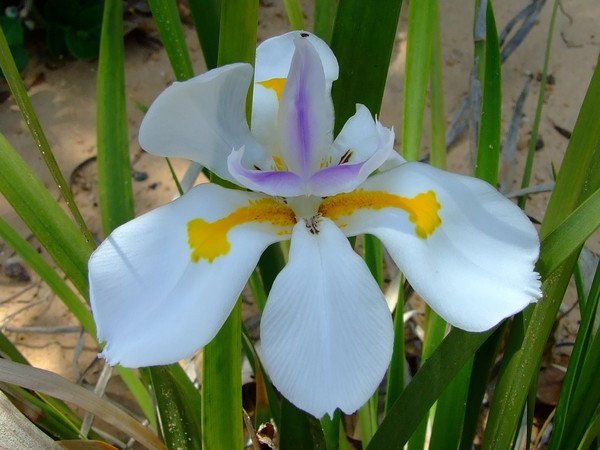


Source
Source
Source
Most species are native to southern and central Africa, with one (Dietes robinsoniana) native to Lord Howe Island off the coast of Australia. A few species have become naturalized in other parts of the world.
Source
magoo-2 found a series of multi accounts of a same owner is following your articles to cheat your generous rewards.
magoo-2 found these accounts are suspicious & can be multi accounts of a single owner. Conclusion is based on last 30 days transactions:
@alves
@devid1996
@mhyeasin
@sadikulaziz
@msena
@kilee
@ripon1
@googlefighter
@melianasagita
@ashasikder
@hichako
magoo-2
Check our latest multi comment spam update report
This well known indigenous large wild iris is commonly grown in gardens and used in large landscapes throughout the country. It is a perennial, evergreen plant which grows up to 1.5m in large clumps.
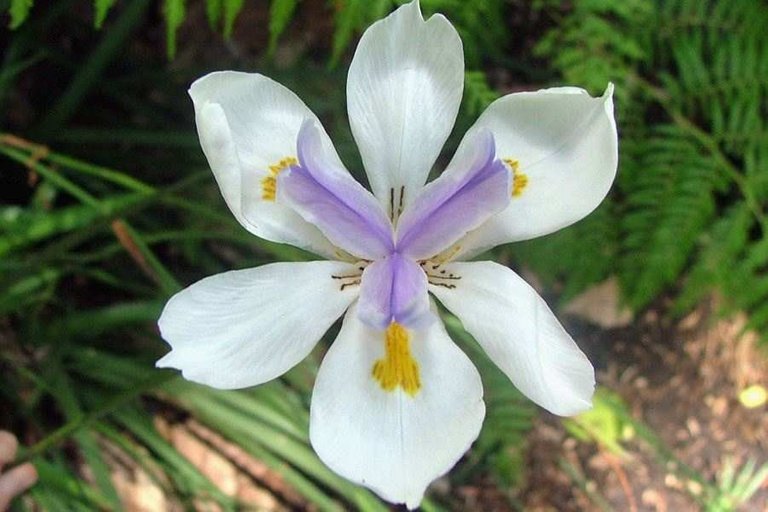


image source
Dietes grandiflora is a perennial, evergreen plant which grows up to 1.5m in large clumps. The plants grow from underground rhizomes.
image source
The long, rigid, sword-shaped leaves, held in a fan shape, are dark green and may reach up to 1m long and 15-20mm wide.
image source
The attractive flowers, held on erect slender stems about 1m in length, are large (about 100mm across) and are white with yellow nectar guides and outer tepals and violet central segments.
content source
Always like those attractive plants that only require a brown thumb. :-)
Surprisingly, I have seen a lot of irises, but with such a shape of flowers I have never met. In irises, which grow in our flower shape resembles a snapdragon.
Here are the usual irises to me
In the first photo, the flower in color resembles exactly the flower of the plant, which we call night blindness. he has a poisonous milky sap that can take away his eyes if he gets into his eyes.
On the second photo of the flower is a completely different form. This plant is an imitator)))
Thank you for the interesting pictures and useful information!
Dietes are not really a true Iris, this is just another common name for them.
Wow,just outstanding.
Thank you so much for sharing dietes suggestion.
This is good the plants of garden and photography very nice.
Dietes grandiflora - wild iris
Grassy plant, ideal for landscaping, weed suppressing and erosion control. Hardy, ideal around waterways or soaks. Charming white iris-like flowers with lilac centres, on tall 120cm stems. Larger plant than the similar-looking iridiodes, with longer-lasting larger flowers.
DESCRIPTION: Clumping grassy plant with tall straight flowering stems. Flowers are white, open, iris-like hence the name; large and white.
USES: Companion planting, erosion control, weed suppression, low maintenance gardens, landscaping, borders and edging, waterway banks.
CARE: Drought and frost hardy so little maintenance is needed after initial care.
PLANTING: Does well in most situations and tolerates wet but well drained soil. Responds to fertiliser and can be lifted and divided to get numbers.
HEIGHT: 1.2 x 1.2 metre
PLEASE NOTE: These plants are tube-stock plants, with the benefit of being a young plant they will establish quickly in your garden. The average size of your plants will be 15 -25 cm in height with a pot size of 42 mm wide and 80 mm high.
http://www.australianplantsonline.com.au/dietes-grandiflora.html
Lovely plant my friend and Dietes bicolor produces fan shaped clumps of iris like narrow sword-shaped basal evergreen leaves. Attractive Iris like flowers appear on the branched stalks from spring to autumn and intermittently throughout winter.

Each flower has three light yellow petals with dark brown blotches 5cm wide.
Seeds germinate readily, however they do have a hard outer coating which is impervious to water and generally germination will normally not occur unless the seed is scarified by abrading or pre-treated with boiling water first.
Cultivation
Plants prefer dappled shade to full sun where they will flower in profusion, though they will grow in shaded areas (with an accompanying loss of flower production). Under favourable conditions, the clumps multiply rapidly. Dietes grandiflora are drought and frost hardy, making them popular for en masse plantings.
Notes
Wild iris (Dietes iridioides) is regarded as a potential environmental weed or a "sleeper weed" in many parts of southern Australia. It has been reported from urban bushland in the Hornsby Plateau region to the north of Sydney Harbour and also from remnant patches of native woodlands in the Maranoa Gardens in suburban Melbourne.
source
magoo-2 found a series of multi accounts of a same owner is following your articles to cheat your generous rewards.
magoo-2 found these accounts are suspicious & can be multi accounts of a single owner. Conclusion is based on last 1 year transactions:
@faizazohaib
@faraz33
@zohaib336
@shoaib721
magoo-2
Check our latest multi comment spam update report
The bicolor diet is an annual plant that is arranged in a thick clump and has a rhizome. This plant has long, sword-like leaves, pale green leaf color. This plant belongs to the Iridaceae tribe, related to the Iris flower
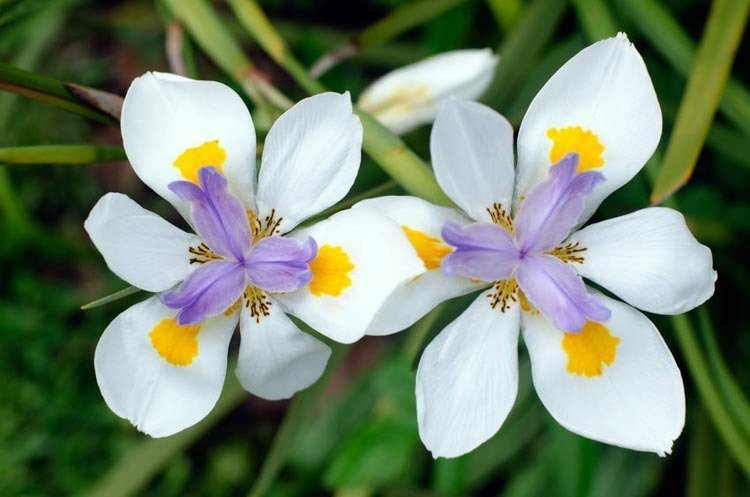.jpg)
Diets bicolor (Dietes bicolor) Rhizome perennial 60-90 cm tall. Leaves are basal, narrowed-xiphoid, light green, 60 cm long. Light yellow to bright yellow, flowers 4 cm in diameter with 3 large perianth petals and brown spots at the base. Flowering in May and June.
Flowers from the tip of the flower Nectar stalk are located on the outer edge. Flowers that bloom only last for one day because the number of buds is very large, the Diet plant continues to grow until October or in the spring and summer.
A bicolor diet is tolerant to dry environmental conditions and also frozen conditions. This plant can also grow easily in soil conditions that do not allow it to grow properly in environmental conditions with partial shade but still full sunlight.
source
magoo-2 found a series of multi accounts of a same owner is following your articles to cheat your generous rewards.
magoo-2 found these accounts are suspicious & can be multi accounts of a single owner. Conclusion is based on last 1 year transactions:
@faizazohaib
@faraz33
@zohaib336
@shoaib721
magoo-2
Check our latest multi comment spam update report
[-]voteman (53) · yesterday
Wow really amazing photography. nice color flowers garden. i love look.
For your post propagation.
Upvote/Resteem
About Dietes Flowers Dietes plant information says this plant is commonly called African iris or Butterfly iris. Dietes plant blossoms are showy and last just a day, sometimes two. Dietes iris normally has a long period of bloom, so you can expect continued blossoms for several weeks.
Learning how to take care of Dietes flowers is not difficult, but will vary depending upon the location in which they’re planted. Multiple blooms appear on upright stalks during the bloom season in spring and early summer and often sporadically throughout the year. Three-inch flowers are white, often marked with yellow and blue.
Dietes is a genus of rhizomatous plants of the family Iridaceae, first described as a genus in 1866. Common names include wood iris, Fortnight lily, African iris, Japanese iris and Butterfly iris, each of which may be used differently in different regions for one or more of the six species within the genus.
Although seed can be sown most of the year in Australia seed is generally best sown in spring or autumn, avoid the coldest and hottest months of the year. The optimum germination temperature for germination is around 15-20°C.
source
magoo-2 found a series of multi accounts of a same owner is following your articles to cheat your generous rewards.
magoo-2 found these accounts are suspicious & can be multi accounts of a single owner. Conclusion is based on last 1 year transactions:
@faizazohaib
@faraz33
@zohaib336
@shoaib721
magoo-2
Check our latest multi comment spam update report
Dietes grandiflora

Dietes grandiflora (large wild iris, fairy iris) is a rhizomatous perennial plant with long, rigid, sword-like green leaves belonging to the Iridaceae family. This species is common in horticulture in its native South Africa, where it is often used in public gardens, beautification of commercial premises and along roadsides.
The blooms are white marked with yellow and violet. Dark markings are found at the base of the outer tepals. These are borne in abundance during summer, especially after rain. Flowers are followed by 5 cm long green capsules that contain very dark brown seeds, these are dispersed when the capsule splits open.
Cultivation
Plants prefer dappled shade to full sun where they will flower in profusion, though they will grow in shaded areas (with an accompanying loss of flower production). Under favourable conditions, the clumps multiply rapidly. Dietes grandiflora are drought and frost hardy, making them popular for en masse plantings.
Environmental weed
D. grandiflora is considered an "environmental weed" in parts of Australia, particularly Western Australia, Queensland, and Lord Howe Island.[1]
References
Turner, Sharon (December 2001). "Dietes grandiflora DC". Witwatersrand National Botanical Garden: South African National Biodiversity Institute, South Africa. Retrieved 2008-12-03.
Large wild iris, Dietes grandiflora, Weeds of Australia, Biosecurity Queensland Edition [1]
https://en.wikipedia.org/wiki/Dietes_grandiflora
magoo-2 found a series of multi accounts of a same owner is following your articles to cheat your generous rewards.
magoo-2 found these accounts are suspicious & can be multi accounts of a single owner. Conclusion is based on last 30 days transactions:
@rik432
@ratul8940
@rahul72
@villani
@Wilson
@masud90
@purepinag
@sumonsha
@taylor10
magoo-2
Check our latest multi comment spam update report
Dietes grandiflora
Dietes grandiflora (large wild iris, fairy iris) is a rhizomatous perennial plant with long, rigid, sword-like green leaves belonging to the Iridaceae family. This species is common in horticulture in its native South Africa, where it is often used in public gardens, beautification of commercial premises and along roadsides.
The blooms are white marked with yellow and violet. Dark markings are found at the base of the outer tepals.
This plant is really a tough plant. It will be found only on the outskirts of the city. It has three colors of flowers which look good. But there are also its sharp leaves that can cause harm.
The leaves are not very sharp, quite safe to be around.
Dietes x 'Nola Alba'
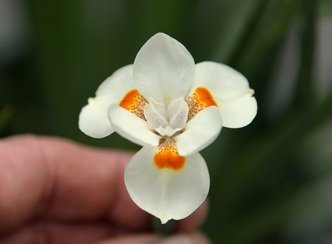
Katrina African iris
This plant was patented as Dietes x 'Nola Alba' and is being marketed as Katrina African iris. The patent description says that it is a hybrid of Dietes bicolor and D. iridioides. It is reported to have more flowers per stalk and have a longer flowering season because it produces few seeds than the parents. The leaves are similar to those of D. iridioides but are longer, wider and darker green. The flower is similar in shape to that of D. bicolor but is smaller and opens pale yellow. Each flower is open for one to two days. The plants are reported to be cold hardier and more resistant to crown rot in moist soils - like D. bicolor. The plant is listed for zone 8 and south. Based in its parentage, I suspect that plants will be more reliably cold hardy in zone 8b than in zone 8a.
I found plants recently in a local nursery. It is being distributed by a large national wholesale nursery. Since it is patented, this plant may not be propagated for sale or distribution without approval by the patent holder. 'Lemon Drop' and 'Orange Drop' are reported to be similar hybrids with the same parentage. They are uncommon but may be found in mail order catalogs.
I purchased a plant of 'Nola Alba' recently to try in my upper zone 9a garden. It was in flower when I got it in late May. It continued flowering into August and began flowering again in November.
magoo-2 found a series of multi accounts of a same owner is following your articles to cheat your generous rewards.
magoo-2 found these accounts are suspicious & can be multi accounts of a single owner. Conclusion is based on last 30 days transactions:
@rik432
@ratul8940
@rahul72
@villani
@Wilson
@masud90
@purepinag
@sumonsha
@taylor10
magoo-2
Check our latest multi comment spam update report
There are five indigenous species of wild iris – Dietes bicolor, D. butcheriana, D. flavida, D. grandiflora and D. iridioides. All these species, but especially the yellow wild iris (D. bicolor) and the large wild iris (D. grandiflora), make attractive garden and landscape plants. The blooms of the latter two are borne on top of long flower stalks above 90cm-tall foliage. Their leaves are evergreen and grass-like, and the plants grow to form attractive clumps.
https://newenglander.smugmug.com/Nature/Plants-and-Flowers/i-jrSfDKQ
magoo-2 found a series of multi accounts of a same owner is following your articles to cheat your generous rewards.
magoo-2 found these accounts are suspicious & can be multi accounts of a single owner. Conclusion is based on last 1 year transactions:
@jacqueline5
@african1
@merina
@marizanne
@miller1
@jerry1994
@aarshi
@nawmi
@maisha
@jenifer2
@masud1
@jerry2
@selina2
magoo-2
Check our latest multi comment spam update report
Lovely plant my friend and Dietes bicolor produces fan shaped clumps of iris like narrow sword-shaped basal evergreen leaves. Attractive Iris like flowers appear on the branched stalks from spring to autumn and intermittently throughout winter.

Each flower has three light yellow petals with dark brown blotches 5cm wide.
Seeds germinate readily, however they do have a hard outer coating which is impervious to water and generally germination will normally not occur unless the seed is scarified by abrading or pre-treated with boiling water first.
Cultivation
Plants prefer dappled shade to full sun where they will flower in profusion, though they will grow in shaded areas (with an accompanying loss of flower production). Under favourable conditions, the clumps multiply rapidly. Dietes grandiflora are drought and frost hardy, making them popular for en masse plantings.
Notes
Wild iris (Dietes iridioides) is regarded as a potential environmental weed or a "sleeper weed" in many parts of southern Australia. It has been reported from urban bushland in the Hornsby Plateau region to the north of Sydney Harbour and also from remnant patches of native woodlands in the Maranoa Gardens in suburban Melbourne.
source
magoo-2 found a series of multi accounts of a same owner is following your articles to cheat your generous rewards.
magoo-2 found these accounts are suspicious & can be multi accounts of a single owner. Conclusion is based on last 1 year transactions:
@faizazohaib
@faraz33
@zohaib336
@shoaib721
magoo-2
Check our latest multi comment spam update report
https://encrypted-tbn0.gstatic.com/images?q=tbn:ANd9GcQ-hbvAJ8SDk7ug6m3IZMkFPLUQhidoleA9HlOz5XYhXYhI5bAsew
https://encrypted-tbn0.gstatic.com/images?q=tbn:ANd9GcQ-hbvAJ8SDk7ug6m3IZMkFPLUQhidoleA9HlOz5XYhXYhI5bAsew
https://www.lowes.com/pd/3-43-Gallon-Fortnight-Lily-L9397/4759448
magoo-2 found a series of multi accounts of a same owner is following your articles to cheat your generous rewards.
magoo-2 found these accounts are suspicious & can be multi accounts of a single owner. Conclusion is based on last 1 year transactions:
@jacqueline5
@african1
@merina
@marizanne
@miller1
@jerry1994
@aarshi
@nawmi
@maisha
@jenifer2
@masud1
@jerry2
@selina2
magoo-2
Check our latest multi comment spam update report